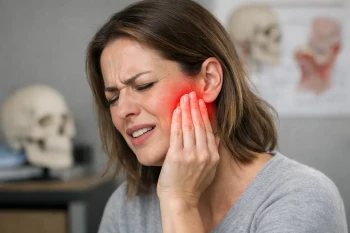
Understanding the Upper Cervical Spine and Trigeminal Neuralgia
The upper part of the spine is known as the upper cervical spine or the craniocervical junction. This area of the spine is the most mobile part of the spine and is susceptible to injury and displacement. The upper neck is also the most neurologically sensitive areas of the spine, and when injured can cause a host of neurological side effects.
Trigeminal neuralgia is a term used to describe the condition of intense burning nerve pain along the distribution of the 5th cranial nerve. This nerve has three main branches that extend across the face and jaw. Its primary job is to transmit sensation from the face to the brain. As the nerve fibers travel from the face back to the brain, they are relayed through the brainstem where it’s nuclei (or main nerve cell bodies) begin.
The brainstem is a region of the central nervous system that inhabits the lower skull and upper neck, being protected by the bony structures of the skull base, atlas, and axis vertebrae. There are tissues that form direct connections between the brainstem and these spinal structures including the dentate ligaments and myodural bridge. This means that mechanical tension can be transmitted from the upper cervical spine to the brainstem when it has become misaligned.
When the nerve fibers of the trigeminal nerve are irritated or affected by this mechanical tension, symptoms of Trigeminal Neuralgia may develop over time.
How to Understand Trigeminal Neuralgia Symptoms
Trigeminal nerve symptoms differ from other pain syndromes in a few ways. Trigeminal neuralgia is primarily an issue of hypersensitivity, which means that an otherwise low-grade stimulus to the face or jaw produces an intense pain response. This means that very minor brushes, touches, or even the feeling of wind on the face can trigger an episode of trigeminal neuralgia.
Typically, trigeminal neuralgia occurs in episodes that may last for second in several bouts, or for prolonged periods of time. It is unpredictable and extremely painful earning the reputation as “the suicide disease.”
What Can Cause Trigeminal Neuralgia Symptoms
Trigeminal nerve symptoms are typically caused by injury or insult to the nerve fibers themselves or to the central nervous system itself. Patients with trigeminal neuralgia typically have a history of injury to the cervical spine such as a motor vehicle collision, concussion, or whiplash type injury. Trigeminal neuralgia symptoms may also be triggered following dental procedures that irritate or damage the lower branch of the trigeminal nerve. This inflammation and irritation can produce a hypersensitivity of the nerve which then triggers trigeminal neuralgia attacks.
In rare instances, a blood vessel is wrapped around the trigeminal nerve or its branches causing a constriction.
What to Do About Trigeminal Neuralgia Problems
Most conventional treatments for trigeminal neuralgia include pharmaceutical drugs that are designed to numb or blunt the sensation of nerve pain such as anticonvulsants. Botox injections are a second line of treatment if pharmaceutical treatments are ineffective or the side effects are to serious. More invasive surgical procedures can involve nerve ablation, microvascular decompression, gamma knife ablation, and more.
Most Common Reasons Adults Have Trigeminal Neuralgia Problems
While each person is different, there are common injuries that underly trigeminal neuralgia for many adults. Injury to the upper cervical spine in a motor vehicle collision, sports injury, or after a concussion are very common predisposing factors to trigeminal neuralgia problems. These types of injuries produce a mechanical displacement of the upper cervical spine. These displacements may be highly sensitive neurologically due to the high concentration of nerve receptors in the joints, ligaments, and muscles of the upper neck. The combined structural displacement and neurological compromise to the upper neck is known as an upper cervical subluxation.
The cascade of negative nerve impulses from the damaged tissues of the upper cervical spine may produce a hypersensitivity of the central nervous system to pain, a phenomenon known as central or peripheral sensitization. This hypersensitivity means that patients with upper cervical subluxation may experience abnormal pain sensations such as an extreme level of pain to other wise normal stimulation. As a hallmark of trigeminal neuralgia, these symptoms that spill over from the injured upper cervical spine may be the underlying cause of trigeminal neuralgia problems in certain individuals.
Diagnosis of Trigeminal Neuralgia Problems
The accurate diagnosis of trigeminal nerve problems and the underlying causes is essential for appropriate and effective treatment. To determine if trigeminal neuralgia symptoms may be caused by or related to upper cervical subluxation, a detailed history and examination must be performed.
Proper diagnosis is based on the unique features of the patient’s history, current experience of trigeminal neuralgia, and objective testing criteria including imaging (x-ray, CBCT, MRI) and neurological testing. In a chiropractic setting, upper cervical doctors take a series of very specific x-rays to measure the structural displacement of the upper cervical spine in order to determine its most safe and effective correction.
Upper Cervical Chiropractic Treatment for Trigeminal Neuralgia Problems
Patients with trigeminal neuralgia problems commonly find natural relief under upper cervical chiropractic treatment. Many patients who consult with upper cervical doctors have already tried conventional treatments with little to no relief. For these individuals, finding lasting relief and a return to normal living may literally be a matter of life and death.
Upper cervical treatment will be focused on detecting any overlooked neck injuries that are causing nerve irritation to the central nervous system or trigeminal nerve nuclei. Using safe and effective adjustment procedures upper cervical doctors work to correct the spine without twisting, popping, or cracking the joints of the neck. Over time patients are monitored to be sure that they are maintaining their alignment so that they can heal and recover from trigeminal neuralgia problems.
Co-management with other specialists may be required to achieve maximal resolution, and upper cervical doctors routine




Leave a comment